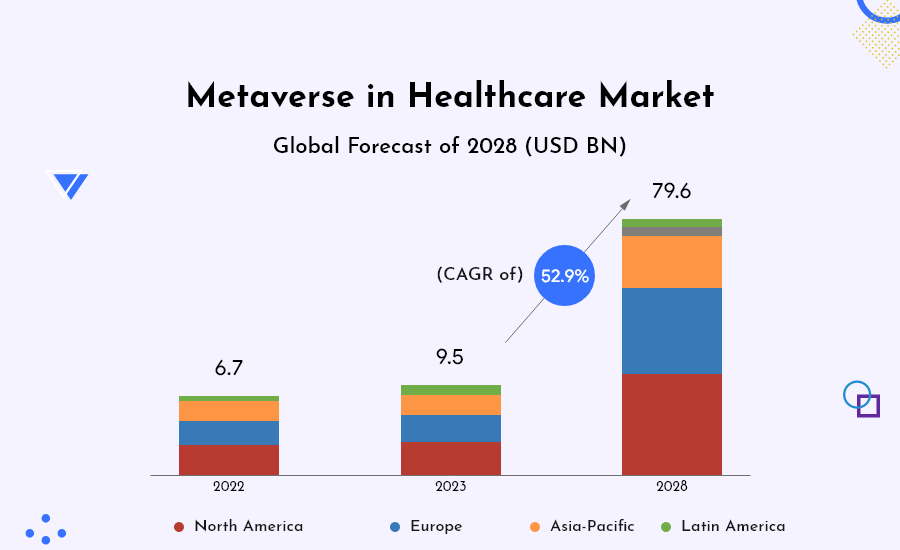According to a survey, the global revenue of the metaverse in healthcare is estimated to be worth 9.5 billion USD in 2023. This value is further expected to increase at a CAGR of 52.9 % (2023 – 2028). This way it can reach a whopping 79.6 billion USD by 2028.
Needless to say, the metaverse is still in its early phases, but it is growing at a rapid pace. This is a technology that integrates Web 3.0, augmented reality (AR), virtual reality (VR), and artificial intelligence (AI), and has huge potential in the field of healthcare.
Robotics, quantum computing, the Internet of Medical Devices, and so on, you name one, are all positioned to fundamentally alter the healthcare industry. The metaverse is anticipated to alter the paradigm of the healthcare system, enhancing therapeutic use, surgical accuracy, and much more.
Considering these factors, this article will provide you with a glimpse into how metaverse development services are reshaping the healthcare sector and the potential it offers for patients, healthcare practitioners, and investors.
Let’s Begin!
How Metaverse Is Transforming The Healthcare Sector?
Metaverse is one of the key technologies that carry the ability to drastically simplify healthcare operations. Let’s understand the same through some examples.
1. Virtual Hospitals
This comprises a virtual reality medical setting with a headgear that focuses on counselling and physiotherapy services. For instance, in physiotherapy, computer vision is used to assess the range of motion in injured joints and the degree of rehabilitation in patients. A virtual hospital, for instance, is being actively developed by Latus Healthcare (the UK) and will be made available as a service within the next few months.
On the other hand, the Apollo Hospitals Group (India) has disclosed a ground-breaking partnership with 8chili Inc. to enter the metaverse via a virtual medical setting. By providing general surroundings with relaxing “narratives” that will induce control over one’s own body and physiological response, pre-and post-operative virtual reality patient counselling in the metaverse will help to improve patient outcomes.
In addition to this, it will also include users in VR-based activities to improve their ability to exercise emotional control. Whether we talk about patient satisfaction or results both will be enhanced by this tailored approach.
2. Data Visualization & Training
When diagnosing and monitoring a patient’s reaction to treatment, doctors frequently find that visualizing patient data obtained from diagnostic tests and other imaging scans proves to be beneficial. In the future, doctors will have access to beneficial tools like data presented in three dimensions in a flexible virtual environment like the Metaverse, enabling speedy assimilation of useful information and useful therapeutic decisions to be made.
Such innovations would also be extremely helpful in education and training, possibly enabling aspiring medical professionals to observe operations, autopsies, and other medical procedures firsthand in an entirely safe setting. The importance of such a training tool cannot be overstated; in other industries, like aviation, where realistic virtual training simulators are already widely used.
Additionally, significant savings in the cost of training cadavers and other consumables could be made after the first investment in software and virtual reality equipment, enabling a larger throughput of qualified personnel.
3. Metaverse Surgeries
The field of medical surgery has shown a remarkable zeal to quickly adopt new technologies. It is obvious that the metaverse is not an exception, and you will easily find a lot of examples of successful use of the virtual dimension to “rehearse” intricate surgeries before one must carry them out on actual patients.
The good thing about metaverse is it enables surgeons from various locations across the globe to congregate in the same operating room. This will combine their expertise to use it for the patient’s benefit. This also raises the likelihood that world-class surgeons will come on a single platform and will actually participate in the operation. This enables them to use their specialized knowledge in Favor of challenging patients without having to travel and without wasting any time.
During surgery, virtual reality can also offer a detailed vision of the patient’s body, which can help the surgeon better grasp the locations of the target organs and where to direct their tools. Just imagine the scenario where a professional will be able to view a patient’s organs and blood arteries during surgery that are truly buried beneath the skin, tissues, and so on through a virtual replica of their body.
Isn’t that awesome?
4. Patient Therapy
Future patient therapy for a variety of psychological diseases will also rely more on virtual settings like the Metaverse. For instance, exposure to fear has been used to treat a variety of phobias, therefore virtual worlds can be utilized to gently expose patients in a secure setting.
In customized virtual experiences, these therapeutic techniques can also be used to treat other conditions like obsessive-compulsive disorder, anxiety, or depression. It would also be possible for therapist or patient-led support groups to quickly find one another and gather from all over the world in a setting more engaging than a text-based support group. Well, the credit goes to the potential collaborative power of the Metaverse.
On top of that, realistic virtual simulations have a wide range of advantageous prospective uses, many of which are still under exploration as technology advances to meet the challenge.
For instance, haptic sensors that simulate patient movement in a virtual environment may be used in movement rehabilitation and to lessen Parkinson’s symptoms, while distracting virtual reality experiences have shown some promise in the replacement of painkillers during the changing of burn victims’ wound dressings or in the facilitation of child blood collection.
Glimpses of the Future
The creation of the metaverse is not a revolution, but rather an evolution of several technologies that have been combined to produce a world that not only closely resembles the real world, but also considerably improves user experiences and interpersonal interactions.
However, it’s important to acknowledge that this evolution comes at a significant cost. Building and maintaining this interconnected digital universe requires substantial investments in infrastructure and development, which has led to discussions and debates about the long-term sustainability of the metaverse.
Despite the metaverse cost, it promises to usher in whole new work and lifestyle concepts and experiences in these virtual worlds that can both imitate and improve the actual world.
While early adopters included sectors like gaming and retail, other sectors, particularly the healthcare sector, now stand to benefit greatly from the metaverse’s potential.
The metaverse expands on current developments in virtual healthcare, such as Virtual Clinics, the use of AI, augmented reality, human digital twins, training simulations for doctors, and robotics, to improve the experiences of both patients and clinicians.
The metaverse will revolutionize how individuals connect with the outside world and has the potential to modify how medicine and healthcare are practiced, enhancing patient outcomes, the way treatment is delivered, and how patients are treated.








